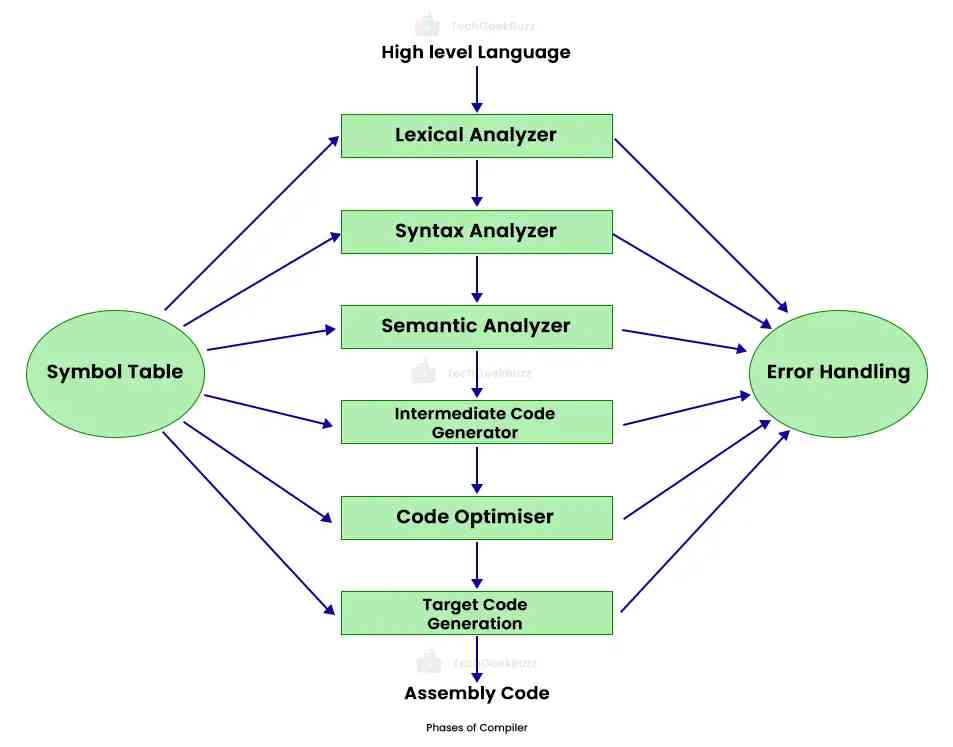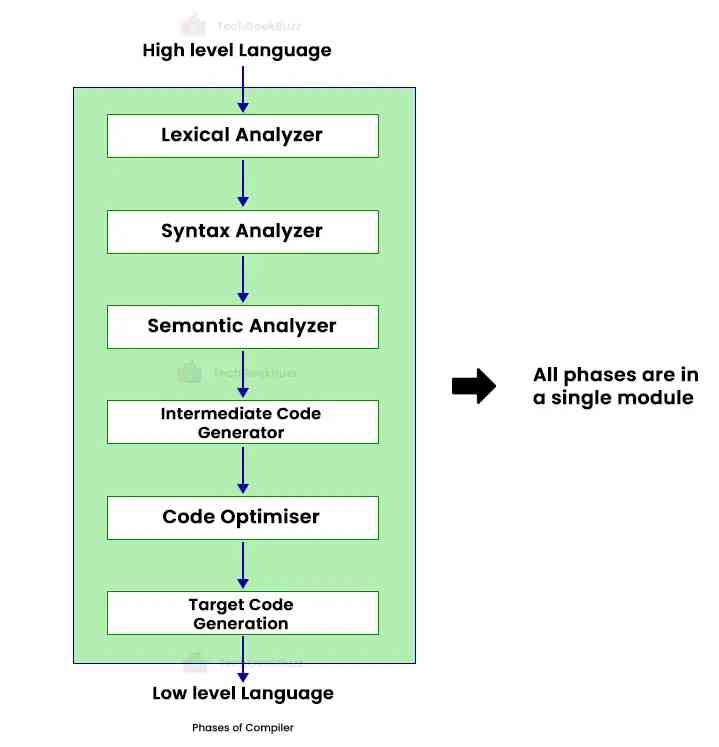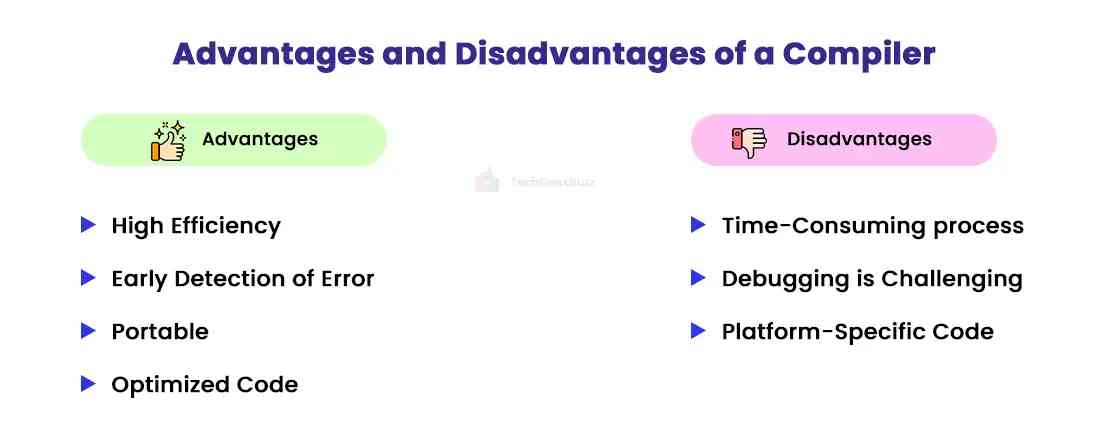A compiler is a software program that translates the code written in a high-level language into machine code. Continue reading this article to learn more about a compiler and its function.
When we write a computer program, we write it in any high-level programming language, such as Python, C++, C, JavaScript, Java and Kotlin . However, a computer cannot understand the instructions you provide using these languages. It only understands the machine code or binary data (0s and 1s).
Machine code is a computer programming language consisting of binary instructions in the form of 0s and 1s.
As a result, it becomes essential to translate the source code into the machine code for a computer to execute it. This is where the role of a language processor, like a compiler or interpreter , comes into play. It translates the source code into machine code or bytecode.
A compiler converts a source code into an executable file containing the machine code for computers to execute. Here, in this article, we shall discuss more about the compiler and how it works.
So, let us get started!
What is a Compiler?

A compiler is a program that translates a high-level language source code into machine code or bytecode. This enables a computer to execute the human-written code.
The process of converting the source code into machine code is called compilation.
In other words, a compiler is a software program that translates the source code written in one programming language into a low-level language. It generates an executable file or program a computer can interpret and execute to generate the desired output.
A compiler can perform some or all of the following functions:
- Preprocessing
- Lexical analysis
- Parsing
- Semantic analysis
- Converting input programs into an intermediate format
Different types of compilers are available out there. Some compilers translate a high-level language program directly into machine code. Meanwhile, some computers translate it into some intermediate code or assembly language.
The Need for a Compiler
Nowadays, we only use high-level languages, like C, C++, Java, Python, Ruby, PHP, etc., which are not machine-friendly. Machines and computers do not have a direct approach to these kinds of languages. This means they cannot understand, interpret, and process instructions written in these languages.
As a result, we need a language processor, either a compiler or interpreter, based on the type of programming language. It converts the source code into a format that computers and machines can understand and execute.
Well, an interpreter is a bit different than a compiler. It reads the source code line by line, translates each line into bytecode, and executes it immediately. On the other hand, a compiler converts the entire source code into machine code and then executes it.
Some programming languages like C, C++, and Java are compiled languages. Python, Perl, and PHP are examples of interpreted languages.
Operations of a Compiler
- A compiler analyzes and breaks the source code into tokens (keywords, identifiers , and operators).
- It checks the source code for syntax errors by arranging it into a hierarchical tree structure called a parse tree (syntax tree).
- It creates the symbol table and intermediate representation of the source code.
- The compiler handles errors occurring in all phases and takes recovery actions.
- It converts the intermediate code into machine code.
Uses of a Compiler
- A compiler makes the source code free from syntax and semantic errors.
- It generates the executable file of the source code.
- It translates the source code from one language to another.
How Does a Compiler Work? [Phases of a Compiler]
A compiler works in 6 phases, from scanning the source code to generating an object code.

These phases are categorized into two major phases - Analysis and Synthesis.
1. Analysis Phase
The analysis phase is concerned with analyzing the source code for semantic and syntax errors and generating it into the intermediate code.
Here are the four analysis phases of the compiler.
-
Lexical Analysis (Lexical Analyzer)
Lexical analysis is the first step of a compiler. It reads every character of the source code from left to right and categorizes it into tokens called lexemes , such as keywords, operators, and identifiers. Hence, it is also known as scanning.
-
Syntax Analysis (Syntax Analyzer)
Syntax analysis is also known as parsing. It analyzes the source code for its syntax. It checks whether the syntax conforms to the rules and guidelines of the programming language in which it is written.
Further, the compiler creates the syntax tree or parse tree that hierarchically represents the logical structure of the source code. This helps it uncover syntax errors.
-
Semantic Analysis (Semantic Analyzer)
This phase of the compiler checks the meaning of the source code to verify it makes sense. It checks whether the program code follows a meaningful approach or not.
Further, it carries out type checking, which ensures that the values used in the source code are of the correct type. Type checking helps programmers uncover errors in the early stages of development.
Type Checking: It is a process of enforcing type constraints on values.
The compiler also validates the source code for semantic errors, such as incorrect function calls and undefined/undeclared variables.
-
Intermediate Code Generation
After all three analysis phases, the compiler translates the parse tree (syntax tree) into the intermediate code. This code is neither in a high-level language nor a low-level language. Any type of compiler can execute this intermediate code. The compiler finds it easy to convert this code into machine code.
2. Synthesis Phase
This phase involves creating the target code or machine code from the intermedia representation of the source code.
Here are the two synthesis phases of the compiler:
-
Code Optimization
This phase of the compiler deals with optimizing the intermediate code. It eliminates any unwanted and useless lines from the intermediate code. Its primary aim is to make the code execute faster with minimum resources, such as CPU and memory.
However, it is important to note that the original meaning of the source code should remain intact.
-
Code Generation
This is the most important phase of the compiler, which accepts the sequence of code from the optimization phase and converts it into object code.
Besides these phases, two other important elements of the compiler are the symbol table and error handling. Each compiler phase is associated with the symbol table and error handling.
-
Symbol Table
A symbol table is a data structure a compiler creates to store information related to the declaration and appearance of keywords, identifiers, constants, and procedures in the source code.
-
Error Handling
Error handling in a compiler is responsible for detecting errors in any phase, reporting them to the user, making recovery strategies, and implementing them to eliminate or handle errors.
Types of Compilers
Three major types of compilers are Single Pass, Two Pass, and Multipass.
1. Single-Pass Compiler

A single-pass compiler, or a one-pass compiler, combines all phases of the compiler in a single module. It simply reads the source code and converts it into machine code directly. The compiler passes through each phase only once.
Single-pass compilers are faster and more memory-efficient than two-pass and multipass compilers.
2. Two-Pass Compilers

A two-pass compiler processes the source code twice. The above working of a compiler depicts the working of a two-pass compiler. It has two parts - analysis or front-end and synthesis or back-end.
The original source code is converted into an intermediate representation in the analysis part. Further, the synthesis part involves processing the intermediate code into the target code.
3. Multipass Compilers

A multipass compiler processes the source code multiple times. It breaks a program into smaller code blocks and processes them all simultaneously. Hence, it results in multiple intermediate codes.
Advantages and Disadvantages of a Compiler

Here are the remarkable advantages and significant disadvantages of a compiler:
Advantages
- Efficiency: A compiler offers better performance than an interpreter. It compiles the source code by optimizing it to the target machine’s architecture. This results in efficient execution.
- Error Checking: The compiler performs comprehensive error checking throughout the compilation process. It uncovers syntax, semantic, and logical errors in the early stages of development.
- Portability: The compiler generates an executable file once you compile a specific program. You can run this file on the target machine without requiring the source code.
- Optimization: The compiler optimizes the intermediate code by removing unwanted and unnecessary lines. This improves resource utilization and performance.
Disadvantages
- Time-Consuming: As the compiler involves the compilation process, it takes a longer time for the source code to convert into machine code. However, this is different with an interpreter. It directly translates instructions into the target code.
- Difficulty in Debugging: The compiler provides all errors in the source code at once after compilation. This becomes difficult in debugging errors.
- Platform-Specific Code: The compiler generates the platform-specific machine code. Hence, you cannot use it on other platforms.
Conclusion
This was all about a compiler. The compiler just does not convert the high-level code to the object code but also checks its legitimacy. It follows a structured approach to converting the source code into object code. The entire process is divided into six phases, each performing a specific activity on the source code.
We hope this article was helpful to you in understanding the basics of a compiler. If you have any questions, share them in the comments below.
People are also reading:





Leave a Comment on this Post